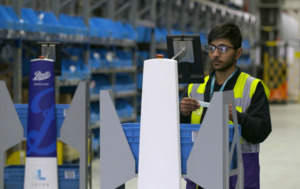
 |
Charlotte Stonestreet
Managing Editor |
| Home> | AUTOMATION | >Robots | >Intelligent automation |
Intelligent automation
08 November 2022
Charlotte Stonestreet speaks to Kary Zate senior director marketing communications at Locus Robotics about the company's meteoric rise and how users can gain in terms of efficiency, agility and operational resilience
They say that necessity is the mother of invention, and Locus Robotics, the spinoff from global 3PL provider Quiet Logistics was born out of necessity when the Kiva mobile robot system, of which the company was an early adaptor, was acquired by Amazon. Discerning that automation was a pivotal part of its operation, and indeed the future of its operation, Quiet Logistics drew on its experience using Kiva robots and set out to devise something even better.
Once the first Locus autonomous mobile robot (AMR) was constructed, it took less that three years to develop the software to go with the system and it wasn’t long before the potentially huge market for the mobile robots was recognised.
Subsequently, Locus has established a strong presence worldwide and in the UK counts healthcare giant, Boots, as one of its larger customers, with over 250 units at one site alone. Interestingly, while in many cases the pandemic acted as a catalyst when it came to implementing automation, Boots had actually started its Locus journey prior to 2019.
Looking back to the start of the project, Locus senior director marketing communications Kary Zate recalls: “Operationally they were using an automated storage and retrieval (ASRS) system in a building that had reached capacity, and for the operation to increase capacity was going to take about a year and a half.”
Looking for an alternative
Shutting down the operation for the period required to upgrade was not an option, so the team at Boots started to look into alternatives, and discovered that the Locus System could provide higher performance levels than the ASRS already in place.
“It went online literally three months before the pandemic happened,” says Zate. “After the pandemic hit and everything shut down here in the UK, those in charge of the operation basically said that if wasn’t for Locus being there it would have been a total disaster!”
Depending on the application, the Locus solution is suitable for deployment at brownfield sites where there are already e-commerce systems in place, as well as in greenfield situations.
“We can go into an existing system, pretty much any warehouse, without having to reconfigure and be up and running because we can parallel the current workflow very easily,” explains Zate. “The system also gives us the ability to go into greenfield situations where they are evaluating the warehouse site itself and work from the ground up, building a workflow with the client that is more efficient.
The ability to adapt existing Locus installations to suit changing needs is also a big advantage. “If you look at a 3LP, for example, that might have a two-year contract with a customer; if that customer decides to leave at the end of the contract, the 3PL can easily reconfigure the same space to suit a new client without having to shut down. They can be up and running within weeks,” says Zate
Rugged chassis
The locus roots are suitable for use on almost every type of warehouse floor, although the open-grid floors commonly found on mezzanines can be a challenge. The chassis is particularly rugged, and all the weight sits at the bottom to prevent toppling over.
Currently, the AMRs are generally configured to travel between picking stations, as which point a human member of staff picks an item to place onto the AMR. However, says Zate plans are afoot to produce what he refers to as the “holy grail of warehousing’”; to be able to have an autonomous robot, that can autonomously pick as well. “There are still challenges to do with the gripper, so until that technology improves we are still a way away from a completely independent picking and travelling robot, but it is coming.”
Travelling between the picking stations means that the Locus robots eliminate much of the time that an operative would otherwise have to spend doing this. “We can double, and in some cases triple, productivity,” says Zate. It also means that in these days of labour scarcity, warehouse operators can maximise throughput using their existing workforce, and accommodate fluctuations in demand.
“In the post-pandemic world, things have changed, but traditionally this time of year was the run-up to the holidays and that meant companies would be hiring, having to bring in more staff, training people, and having to deal with all the issues around dealing with the coming volume increase. Then once things drop off in January, at least in the US, that workforce is no longer required, and this cycle would repeat itself year after year,” says Zate.
“Now because of COVID and the increase in people ordering online, a lot of those spikes are levelling out. Or you might have several spikes throughout the year. One of the wonderful things about the Locus robots is that when those spikes happen, you can simply add more robots. The workforce can stay the same, but the volume increase can be absorbed.”
Robots as a Service
This is particularly facilitated by the Locus Robots as a Service (RaaS) model. Effectively a subscription service, this eliminates the need for capital outlay and makes the cost of entry much lower. It also means that any upgrades developed by Locus are automatically and remotely added, so the warehouse always has the most up-to-date version of the Locus system.
For operators wishing to add to their fleets, Zate says that the typical lead time would be several months, however, as many operations can anticipate when their peak times will be, this can be built into a contract from the start.
“Interestingly, what we are finding is that after businesses have used the extra robots during peak season, rather than shipping them back to us they decide to keep them because now they have the ability to immediately increase their fleet as needs change,” says Zate.
This agility was particularly valuable during the pandemic when for many companies, the whole notion of what constituted peak periods vanished overnight. Orders went from off-peak levels to ‘black-Friday levels, in some cases, over the space of a weekend and it is nigh on impossible to draft in the labour required to deal with that on such a short time scale. Little wonder then, that since the pandemic, Locus has seen a significant increase in enquiries.
“We’ve had more requests now because it’s not just the volume increase, it comes back to the labour issues. Traditionally, management would just get more people in, but the people aren’t there so they are looking for alternatives and automation is really the way to go,” says Zate.
Quick and easy training
There are also advantages to the Locus system in terms of operator training. It is relatively quick and easy to train a warehouse picker – literally in some cases it takes a matter of minutes, asserts Zate – and this means that management has a bigger pool of labour to draw from as special skills are not required. Each worker is given a near-field Bluetooth tag, and as they approach the robot it can identify the individual worker and operate in their preferred language, which is particularly useful in operations employing multiple nationalities where it improves accuracy and reduces worker stress thereby aiding worker retention.
The Locus system, which is linked to a facility’s warehouse management system (WMS) optimises, the picking process by taking into account the position of the items to be picked and the location of the pickers at any one time. In contrast to a cart picking system whereby each cart may contain several orders, all of which need to be complete before they are transferred to be packed, each Locus robot processes one order at a time and as soon as that order has been picked it is transferred to packing, making for a more efficient operation.
Sophisticated vision systems and Light Detection and Ranging (LiDAR) mean that the Locus robots can see about 30m ahead. If a unit detects a change in the environment, for example, racking has moved, or there is an obstruction in an aisle, it can relay this information to the other units within the warehouse and they will then optimise their routes, again maximising efficiency.
Mindful of issues around operator acceptance, Locus also works with its customers to ensure that the workforce is onboard. “We are finding onsite, when the workers start working with the robots, they really do like them,” says Zate. “The system makes their job easier, it’s safer, and they actually enjoy working with the technology.”
- Balls to Gravity
- ROBOTS GIVE FASTER CELL TOOL CHANGE TIMES
- ROBOT FOR DELICATE ASSEMBLY
- NUMBER OF ROBOTS IN UK ON THE RISE
- The future is bright - The future is automation!
- High Demand For Grant
- More Capacity, Less Space
- FREEBIRD - THE THIRD DIMENSION
- PRECISION ROBOT CELL FOR THE PHARMACEUTICAL INDUSTRY
- ROBOT SALES REACH ALL TIME HIGH




















